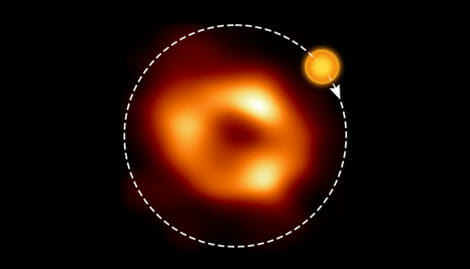
This handout image released by the European Southern Observatory / Event Horizon Telescope (EHT) Collaboration shows a still image of Sagittarius A*, the supermassive black hole at the center of the Milky Way, as seen by the Event Horizon Collaboration (EHT), with an artist’s illustration indicating where the modeling of the Atacama Large Millimeter/submillimeter Array (ALMA) data predicts a hot spot to be and its orbit around the black hole. – Astronomers have spotted signs of a “hot spot” orbiting Sagittarius A*, the black hole at the centre of our galaxy. The finding helps to better understand the enigmatic and dynamic environment of our supermassive black hole. (Photo by M. KORNMESSER / European Southern Observatory / AFP)
PARIS — Astronomers said Thursday they have spotted a hot bubble of gas spinning clockwise around the black hole at the center of the galaxy at “mind blowing” speeds.
The detection of the bubble, which only survived for a few hours, is hoped to provide insight into how these invisible, insatiable, galactic monsters work.
The supermassive black hole Sagittarius A* lurks in the middle of the Milky Way some 27,000 light years from Earth, and its immense pull gives our home galaxy its characteristic swirl.
The first-ever image of Sagittarius A* was revealed in May by the Event Horizon Telescope Collaboration, which links radio dishes around the world aiming to detect light as it disappears into the maw of black holes.
One of those dishes, the ALMA radio telescope in Chile’s Andes mountain range, picked up something “really puzzling” in the Sagittarius A* data, said Maciek Wielgus, an astrophysicist at Germany’s Max Planck Institute for Radio Astronomy.
Just minutes before ALMA’s radio data collection began, the Chandra Space Telescope observed a “huge spike” in X-rays, Wielgus told AFP.
This burst of energy, thought to be similar to solar flares on the Sun, sent a hot bubble of gas swirling around the black hole, according to a new study published in the journal Astronomy and Astrophysics.
The gas bubble, also known as a hot spot, had an orbit similar to Mercury’s trip around the Sun, the study’s lead author Wielgus said.
But while it takes Mercury 88 days to make that trip, the bubble did it in just 70 minutes. That means it traveled at around 30 percent of the speed of light.
“So it’s an absolutely, ridiculously fast-spinning bubble,” Wielgus said, calling it “mind blowing.”
RELATED STORY
Behold the black hole at Milky Way’s center